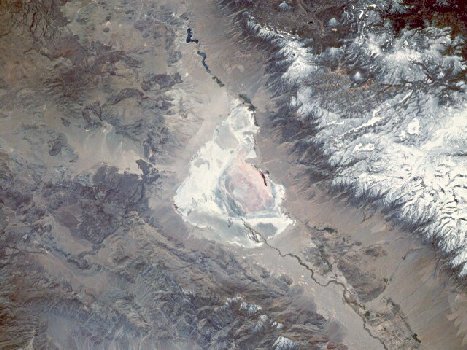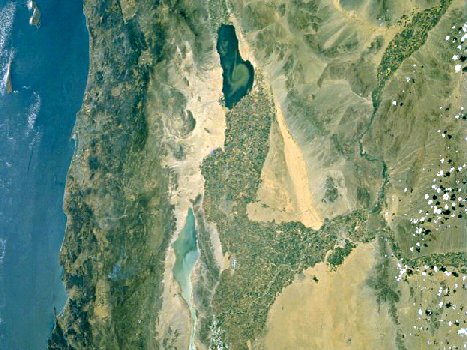| Water Resources |
| As populations grow, an increasing strain is put on the water resources of an area. People need water for drinking and sanitation, for agriculture and industrial processes.
Much of the territory of the Netherlands is land reclaimed from the North Sea. These Landsat images show South Flevoland, partially reclaimed in 1973 (left) and in 1987 (right). In southern California, the demands of the growing city of Los Angeles and the need for irrigation water led to the gradual draining of Owens Lake, which is now a large saltflat. The level of Mono Lake, further north, dropped 15 metres (41 feet) before controls were imposed on extraction in 1991. To the south, the Salton Sea in Imperial Valley is the result of an accidental release of water from an irrigation channel.
Owens Lake, 30 km (18.75 miles) long by 16 km (10 miles) wide in 1905, was drained to provide fresh water for the city of Los Angeles 380 miles away.
The waters of the Colorado River feed large-scale irrigation in Imperial Valley, in the arid southwestern USA. In the middle east, "fossil" groundwater, unreplenished by today's rainfall patterns, is being drained to irrigate crops in Saudi Arabia. In central Asia, the Aral Sea covers less than 40% or its original area, due to the diversion of its inflowing rivers for irrigation. High salt levels have killed off fish stocks and the local climate has become much drier. Salty duststorms, carrying fertilisers and pesticides, have crippled the health of the local population.
The shrinking Aral Sea, viewed by satellite in 1985 (left) and 1992 (right). Hydroelectric power is an attractive option in many countries, but its potential is concentrated in wilderness areas, where the natural environment may suffer from the development. Indigenous populations in Quebec, Turkey and Malaysia have all had their homes and way of life threatened by large-scale dam projects in recent years. In China, flooding has been a huge problem along the Yangtse River, with hundreds of thousands of people killed over the centuries. Today, a huge dam is being built to control the river's flow by creating a 370-mile (592 km) long lake. The project will save lives, ease transport and stimulate the economy, but in the process, 2 million people will be displaced, the scenic Three Gorges stretch of the river will be flooded and major archaeological and cultural sites will be lost. |



